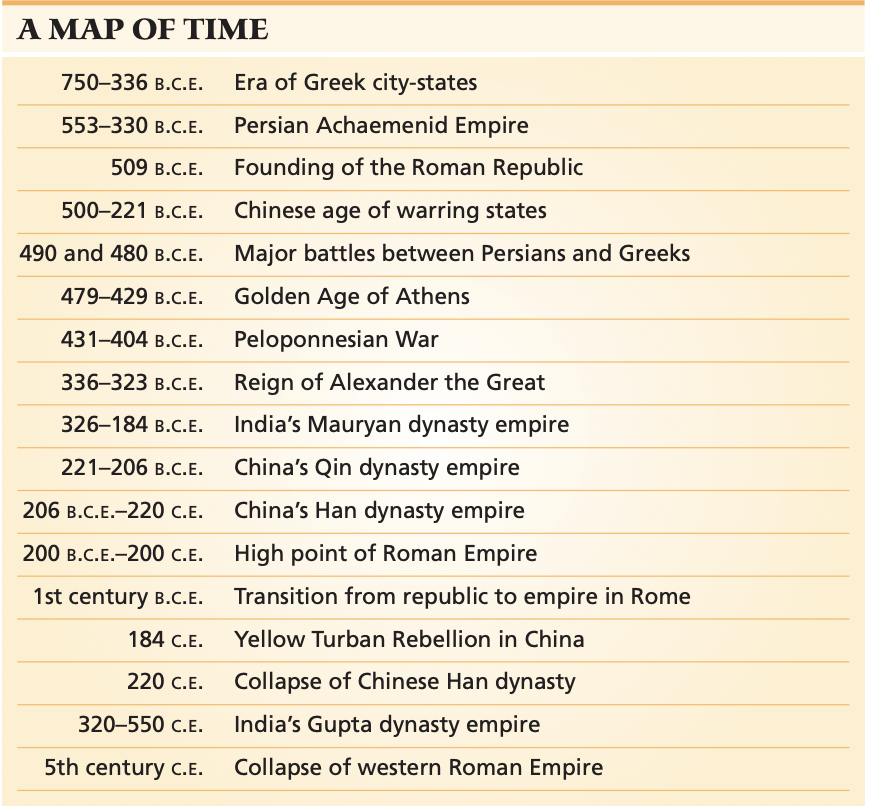WHAP UNIT 0
Ways of The World 3rd Edition Chapter 1 + 2:
a. the emergence of humankind
→ Hominid Divergence: the split from chimps to homo sapiens in eastern/southern africa (5-6 million years ago)
→ started having the ability to walk on 2 feet (bipedalism), found evidence of 2 people walking side by side
→ Homo habilis created the first stone tools 2.3 million years ago (evidence found)
→ The Homo erectus discovered fire for the first time in Eurasia 1 million years ago
→ As cultural transmission increased the Homo Sapiens started spreading to Africa 250 kyr
→ Within 150 kyr, they were dispersed all over the world (Eurasia, Australia, America, and the Pacific Islands)
b. the globalization of humankind (paleolithic era)
→ the old stone age, hunter gatherers > agricultural developments
→ moved every season towards the food
→ art forms in caves came to light
→ lived in clans and used stone tools
c. the revolution of farming and herding
→ neolithic revolution (agricultural)
→ domestication of plants and animals, farming discovered
→ less nomads due to stable food source
→ overall led to a increase in population and change in land due to deforestation
d. the turning point of civilization
→ 1st city-states
→ increase in political institutions
→ large scale wars and rebuilding
→ increase in social classes
→ 1st form of writing; keeping records; upper class scribes
e. time and world history
→ b.c.e. = before common era
→ BP = before present (<1950)
f. migration
→ in the west and east
→ technology: spears, bows and arrows, paintings of animals within caves
→ australia
→ 250 languages developed
→ creation myths started to materialize
→ long distance trade increased
→ americas
→ bering long bridges created
→ clovis culture: big game hunting (mammoths and bison)
→ pacific
→ austronesian expansion → solomon islands
→ canoe use for ocean navigation
→ spread of agriculture and creation of chiefdoms (earliest in HI)
→ overall bad quality of environment due to over farming and deforestation
i. first human societies
→ lived in groups of 25-50, egalitarian
→ moved for the seasons
→ gender roles reflected hunter gatherers
→ increase in violence due to new weapons and > # deaths
→ economy
→ lots of work to do but also a lot of leisure time
→ < 35 years of life expectancy
→ spiritual practices:
→ psychedelic substances
→ shamanic prayers
→ burial rites
→ end of the ice age → stable weather conditions → permanent villages
j. common patterns and variations
→ surplus of crops = boom in population
→ regions
→ fertile crescent: good crops, domesticated animals THE place to live
→ africa: grain based agriculture, cattle
→ america: limited domestic animals and poor agricultural quality
→ types of societies
→ pastural: followed a system of animal herds, relied on dairy
→ agricultural: sedentary due to developed farming areas, social life was split into jobs
→ had social classes and inequality increased due to increase in slaves
k. rise of the states
→ states > clans
→ used religion to drive government and law
→ crimes dealt with through harsh punishments such as beating and drowning
→ first types of checks and balances, no room for totalitarian gov.
→ systems of writing led to propaganda, laws, and literature/philosophy
l. trading and interactions
→ trade networks spread luxury goods (goods that one place had but others didn’t)
→ technology and ideologies were dispersed
Ways of The World 3rd Edition Chapter 3 + 4:

a. the persians and the greeks
→ between 500 BCE and 500 CE in north africa and eurasia, 2nd wave civilizations were created
→ although most new regions were never together, greece and persia had constant interactions and clashed
b. the persian empire
→ the biggest/most impressive empire was persia (iranian plateau)
→ it was made of the
→
→
→
→
→
→